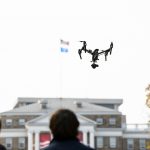Research Vehicle Safety Oversight (Autonomous Vehicles)

(Photo by Jeff Miller/UW-Madison)
UW–Madison encourages safe and lawful use of unmanned aircraft systems (drones) for research and instructional use. The UW–Madison Research Vehicle Safety Oversight (RVSO) Policy helps researchers and instructors meet the Federal Aviation Association’s rules for flying unmanned aircraft systems (UAS) – better known as aerial drones – while also helping to protect privacy.
New Federal prohibition on UAS/drones manufactured or assembled outside of the USA.
UW faculty, staff, students, contractors and affiliates seeking to operate autonomous vehicles, including unmanned aircraft systems (UAS) and ultralight aircraft, for UW-related education, research and non-academic purposes must submit pilot and flight applications in ARROW to the Research Vehicle Safety Oversight Committee for review no less than thirty (30) days in advance of the first proposed flight date. This policy applies to operations in both indoor and exterior spaces and in connection with UW–Madison activities whether occurring within the United States or internationally.
For safety and privacy reasons, drone operations by students, employees or visitors for recreational or hobbyist purposes are still not permitted on UW–Madison premises. Drone operations by registered student organizations and by students in connection with UW–Madison coursework, are eligible to be considered for approval under this policy as instructional uses.
Pilots for instructional or research related flights may hold either a TRUST Certificate or Part 107, Remote Pilot in Command (RPIC) license. Contracted pilots must hold a RPIC.
Remote Pilot in Command (RPIC), Part 107 License
- Supervision of drone flights by uncertified pilots is allowed
- Required for contracted pilots and commercial use.
- FAA waivers allowed.
TRUST Certificate:
- Supervision of drone flights by uncertified pilots is not allowed.
- Restrictions include:
- Line of sight flights only
- No interference with manned aircraft.
- The pilot must obtain authorization for operations within Class B, Class C, or Class D airspace or within the lateral boundaries of the surface area of Class E airspace designated for an. airport
- May not fly more than 400 feet above ground level in Class G airspace
- Must adhere to all applicable airspace restrictions and prohibitions
- Not allowed for contracted pilots or commercial use
- No waivers available
Registered student organizations (RSO) in good standing may submit drone related applications to the RVSO Committee for review. RSOs may utilize either the TRUST Certificate or the RPIC, Part 107 license. As part of the application process, RSOs will be required to provide proof of liability coverage. At least $1 million dollars of coverage is required. RSOs must follow all applicable UW–Madison and FAA rules regarding drone flights.
Pilot and flight applications for research and instructional use of drones should submitted through ARROW.
New Federal prohibition on UAS/drones manufactured or assembled outside of the USA.
Recreational or hobbyist unmanned aircraft operations by students, employees or visitors are not permitted on UW–Madison premises. The University also adheres to FAA regulations and does not allow the following without waivers:
- Flight(s) over people
- Flight(s) beyond the line of sight
- Flight(s) at night
- Flight(s) above 400'
- Flight(s) in controlled airspace (requires authorization)
For safety and privacy reasons, drone operations by students, employees or visitors for recreational or hobbyist purposes are still not permitted on UW–Madison premises. Drone operations by registered student organizations and by students in connection with UW–Madison coursework, are eligible to be considered for approval under this policy as instructional uses.
Pilot and flight applications for research and instructional use of drones should submitted through ARROW.
Memo from Associate Vice Chancellor Rickenbach on Federal prohibition on UAS/drones manufactured or assembled outside of the USA.
Federal Drone Manufacturer Prohibitions
FAR Clause 52.240-1: The Federal Acquisition Regulation (FAR) clause 52.240-1, Prohibition on UAS Manufactured or Assembled by American Security Drone Act (ASDA)-Covered Foreign Entities is a federal regulation designed to protect national security by prohibiting the use of drones from specific foreign entities in federally funded projects. It is anticipated that Federal Acquisition Security Council (FASC) will include foreign entities on the Department of Defense (DoD) 1260H List.
DOD 1260H list: This list identifies Chinese military companies that operate directly or indirectly in the U.S. in accordance with Section 1260H of the National Defense Authorization Act for Fiscal Year 2021. The list was updated on January 7, 2025 and includes some of the most popular drones on the market, such as DJI and Autel Robotics.
The list of foreign entities is currently under development and will be maintained by the FASC. Once developed, it will be published in the System for Award Management (SAM) at SAM.gov. It is expected this list will be populated after December 22, 2025.
Restrictions
- Contractors may not deliver, use, or procure any UAS from these ASDA-covered entities in performance of federal contracts where the FAR clause is included in the award. It is anticipated that this clause will be included in all federal contracts moving forward.
- Federal funds cannot be used to acquire or operate such UAS.
- These restrictions must be flowed down to all subcontractors
Compliant Drones
When purchasing a UAS, you should consult the Blue UAS Cleared List. If you plan on purchasing a UAS not included on the Blue UAS Cleared List, contact the Research Security and Export Control Office for a Restricted Party Screen to ensure the manufacturer is not on the prohibited list.
Effective Date
Effective December 22, 2025, Contractors are prohibited from
1) operating a prohibited UAS/drone in the performance of a Federally funded contract or award.
2) using federal funds to procure or operate a prohibited UAS/drone.
If you are flying within five miles of a hospital heliport, you can fly an unmanned aircraft only if it is safe to do so. As a pilot, you must:
- Notify the operator of the heliport and resolve any safety concerns
- Not interfere with manned aircraft
- See and Avoid manned aircraft at all times
